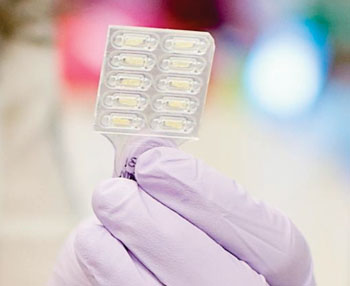Lab-On-Chip Created for Malaria Diagnosis
By LabMedica International staff writers
Posted on 29 May 2014
The laboratory diagnosis of malaria is usually carried out either by microscopy requiring skilled expertise or immunochromatographic rapid diagnostic tests (RDTs), which are not without significant limitations, including decreased sensitivity at lower levels of parasitemia.Posted on 29 May 2014
Molecular diagnostics satisfy the need for malaria diagnosis effectively in developed countries, but barriers in technology, reagent storage, cost and expertise have hampered the introduction of these methods in developing countries, especially in sub-Saharan Africa.

Image: The Accutas “lab-on-chip\" technology which allows technicians in the field to test for malaria, and potentially many other infectious diseases (Photo courtesy of Aquila Diagnostics Systems Inc.).
A team of scientists led by those at the University of Alberta (Edmonton, AB, Canada) created a platform consisting of a disposable plastic chip and a low-cost, portable, real-time polymerase chain reaction (PCR) machine. Archived, frozen samples from malaria patients with a positive diagnosis by PCR were acquired. Blood samples were collected in 2011–2012 in Uganda from consenting pregnant women. Microscopy was performed on thick smears stained with Giemsa.
The chip contains a desiccated hydrogel with reagents needed for Plasmodium-specific PCR. Chips can be stored at room temperature and used on demand by rehydrating the gel with unprocessed blood, avoiding the need for sample preparation. These Accutas lab-on-a-chip malaria detection kits (Aquila Diagnostics Systems Inc.; Edmonton, AB, Canada) were run on a custom-built instrument containing a Peltier element for thermal cycling and a laser/camera setup for amplicon detection.
The diagnostic assay was capable of detecting all Plasmodium species. The plastic chip demonstrated excellent performance within a range of 2 × 105 to 0.2 parasites/μL, consistent with parasite levels observed in the field. This exceeds the sensitivity of microscopy, the current standard for diagnosis in the field, by ten to fifty-fold. In a blind panel of 188 patient samples from a hyper-endemic region of malaria transmission in Uganda, the diagnostic had a high sensitivity of 97.4% and a specificity of 93.8% versus conventional real-time PCR.
The test also distinguished the two most prevalent malaria species in mixed infections, P. falciparum and P. vivax. A second blind panel of 38 patient samples was tested on a streamlined instrument with light-emitting diode (LED)-based excitation, achieving a sensitivity of 96.7% and a specificity of 100%.
The authors concluded that the technology described in their study has the potential to make major inroads by supporting key areas of malaria control as a diagnostic for acute malaria, for surveillance in elimination settings, and as a tool in clinical evaluations of new drugs and vaccines. The chips can be tailored to test for different pathogens, species, or genetic markers, including drug resistance markers, depending on the clinical or public health need. The study was published on May 9, 2014, in the Malaria Journal.
Related Links:
University of Alberta
Aquila Diagnostics Systems Inc.













